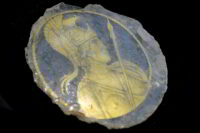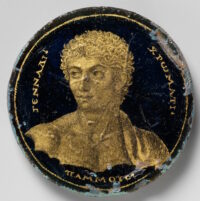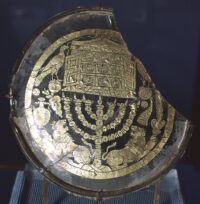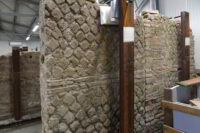
The iconographic theme is already well-known, but it is the first and only representation found so far on golden glass.
“Golden glass is already a very rare finding, but this has no comparison” according to preliminary findings, Simona Morretta, archaeologist of the special superintendency of Rome, explained to ANSA. “No golden glass with the personification of the city of Rome had ever been found before”.
Gold glass was a glass-making technique in which a thin layer of decorated gold leaf, often a portrait, was sandwiched between two layers of transparent glass. The leaf was glued to one glass discs first, then the design created by scratching away tiny areas of gold like an etching. A second glass disc was then superimposed on top of the etched gold surface and fused to create the roundel of a vessel or a medallion.

Religious imagery was a popular motif for gold glass artifacts. Examples with Greco-Roman, Christian and Jewish iconography have been found, many of them deliberately broken and the decorated base affixed to the wall next to burial niches in the catacombs of Rome. About 500 pieces 
There is no inscription on the recently-discovered personification of the Eternal City. She wears an Amazonian-style dress, a helmet with a plumed crest a diadem on the forehead. She carries a spear across her chest. The details are very finely crafted, from the curls of her hair to the scrollwork on the helmet.

The Porta Metronia station is scheduled to open in late 2024. It’s a great location for a museum, a short, enjoyable walk from the Via Appia along a grassy park following a well-preserved section of the Aurelian Wall. I am looking forward to the prospect of walking that stretch again someday and enjoying a unique museum instead of just being cut off by construction chaos.
* This article was originally published here






No comments:
Post a Comment